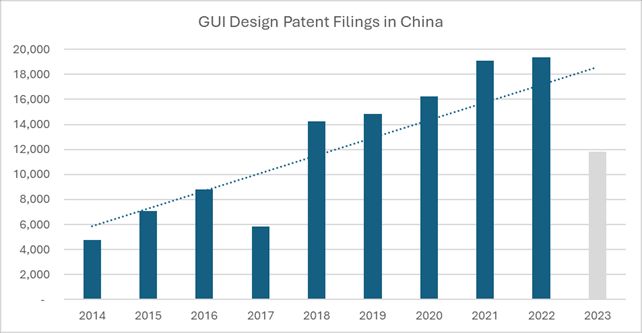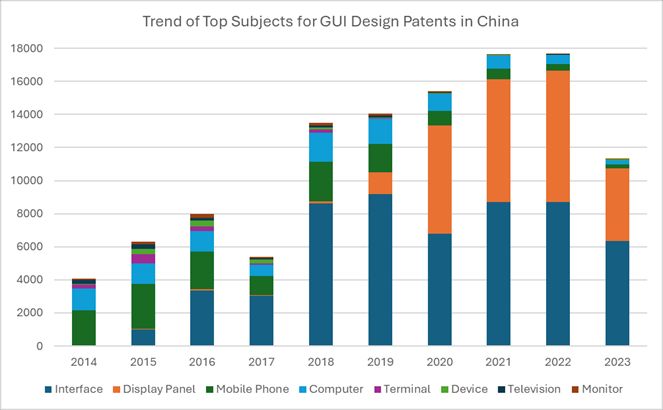Regulatory changes, filing trends and practice.
Graphical User Interface (GUI) is a way of displaying function keys and functional components of equipment, facilitating interaction between humans and the equipment. Since GUI was first introduced in 2014 into the China legal framework as an eligible subject matter for design patents, notable changes have occurred, offering IP owners more possibilities and options for enhanced GUI design protection in China. In this article, we will explore regulatory changes, filing trends, and the practice of GUI design patents.
Regulatory changes
The rules for GUI design patents in China were marked by the following key milestones on the regulatory timeline. Essentially, the regulatory restrictions on GUI design patents in China have been loosened over time.
- Before May 1, 2014, GUI was not protectable by design patents in China. In fact, it was explicitly excluded for design protection in the Guideline for Patent Examination.
- On May 1, 2014, GUI became an eligible subject for design patent protection in China, though bonded to specific products in practice, according to the amendment to the Guidelines for Patent Examination by Order No. 68 issued by the CNIPA.
- On November 1, 2019, restrictions on a GUI design patent for specific products were lifted, according to the amendment to the Guidelines for Patent Examination by Order No. 328 issued by the CNIPA.
- On June 1, 2021, when the fourth amendment to the Chinese patent law became effective, GUIs could be protected by partial designs, and GUI design patents started to enjoy the extended duration of protection from 10 to 15 years.
- On February 20, 2024, when the latest amendment to the Implementing Regulations of the Patent Law and the Guidelines for Patent Examination become effective, more detailed rules were released for the requirements and examination of GUI design patents.
Filing trend
In parallel with the loosening regulations, the filings of GUI design patents are growing strongly in China (see below chart).

(Data source: Patsnap)
Remarkably, GUI design patents filed under the category of "screen displays and icons" (Locarno design classification 14-04) increased fourfold from 2014 to 2022. A large portion of these design patents has been filed by Chinese applicants, although remain underutilized by international applicants. According to our research, less than 3% of Chinese GUI patents published in 2021 to 2023 were filed by international applicants.
Despite this trend, we anticipate that international companies may increasingly recognize the value of protecting their innovative GUI designs in China.
What GUIs can be protected by design patents in China?
We've analysed the subjects of registered GUI designs in China filed from 2014 to 2023 and observed a shift from GUIs bonded with hardware to GUIs independent of hardware. The chart below illustrates how the top subjects for GUI designs change over time.

(Data source: Patsnap)
We've also observed that Chinese GUI design patents are extended from traditional GUIs on computer or mobile phone screens to non-traditional GUIs such as automotive HUD (Head-Up Displays), VR/AR/XR displays, and GUIs related to virtual characters.
Moreover, Chinese design patents on parts or components of GUIs in the form of partial designs have become possible since 2021. Typical subjects for GUI design patents in China include the following:
GUIs independent of hardware
- Graphical user interface
- Software interface
- Interactive interface
- Operating interface
- Display panel for electronic devices
GUIs bonded with hardware
- Mobile phone with GUI
- Computer/tablet with GUI
- Television with GUI
- Display monitor with GUI
- Watch with GUI
Parts or components of GUIs
- Main body of GUI
- Module of GUI
- Area of GUI
- Display Zone of GUI
- Operating Zone of GUI
What GUI/GUI elements cannot be protected by design patents in China
There are also limitations to the patent eligible subjects of GUI design patents. The Guidelines for Patent Examination (Section 7.4, Chapter 3 of Part I) explicitly excluded the following subjects from design protection in China:
- Gaming interface
- Patterns displayed by a display device that are irrelevant to human-machine interaction
- Wallpaper for an electronic screen
- Startup picture or shutdown picture
- Website layout irrelevant to human-machine interaction
It is worth nothing that for an icon in a GUI, if it is just a pattern displayed by a display device unrelated to human-machine interaction, the icon may not be protectable by a Chinese design patent. However, if it is an icon for user-interaction, e.g., launching an APP on an electronic device, it may be considered to be relevant to human-machine interaction and protectable.
Patent Practice
GUI designs will follow the general requirements for a design patent from filing to grant.
Priority
A Chinese design patent may be filed based on a foreign or domestic priority within 6 months from the application date of the first filing. The first filing may be design, patent, or utility model application(s).
Formality requirement
- Title of the GUI design patent shall indicate the use and the applied product(s) of the GUI design.
- Views of the GUI design patent may include the product to which the GUI design is applied, or just the views of the GUI without showing the product, in case the GUI is applicable to any electronic device.
- For dynamic GUI, the starting state of the GUI and key frames of the GUI shall be included in the views to illustrate the complete transition process of the dynamic GUI.
Partial Design
- The whole or partial design must be indicated in the brief description.
- The claimed portion of a partial design can be indicated by
-
- solid line (claimed) and dashed line (not claimed); or
- translucent layer
- The claimed portion of the partial design should be a relatively independent region or relatively complete design unit of the product.
- Pure surface pattern or combination of pattern and colour are not eligible for partial design protection.
- Multiple partial designs with related function or design and providing certain visual effects can be filed in one design application.
- Divisional design application: if the parent design application is a partial design, its divisional application cannot be a whole design, and vice versa.
- Design amendments: the whole design cannot be amended to a partial design, and vice versa.
Examination
A design patent will be subject to formal examination before granting. Examination of obvious differences over prior designs has been introduced as a part of formal examination in the Guidelines for Patent Examination in 2024. This means there is a higher bar for the granting and validity of design patents in China.
Grant
On average, a Chinese design patent may be granted within 3–4 months under the current practice. The examination of GUI design patents may take longer. According to our research, the average pendency from filing to granting is around 7-8 months for GUI design patents filed in 2021 to 2023.
General Recommendations
- Consider the specific requirements for GUI design applications in China as early as possible, if design protection in China is intended.
- Considering the higher bar for granting and validity of Chinese design patents, it's advisable to conduct design novelty search for GUI designs, if stable design patent protection is desired.
- In view of the high volume of GUI design patents filed in China, design clearance search would be helpful to identify and manage the risk of potential design infringement disputes on software or hardware products with GUI to be launched in China.
In summary, as the rules of the game have been changed significantly, we would advise IP owners to explore and utilize the possibilities of improved GUI design patent protection in China.
The content of this article is intended to provide a general guide to the subject matter. Specialist advice should be sought about your specific circumstances.


